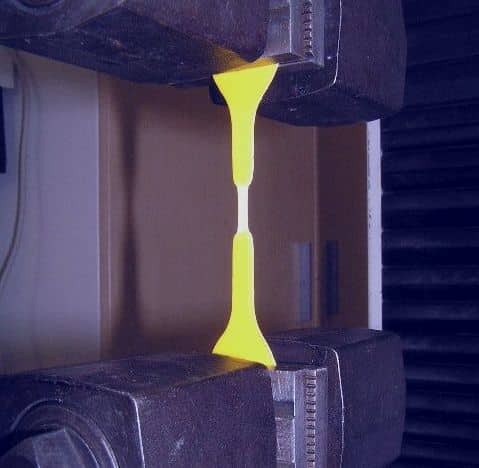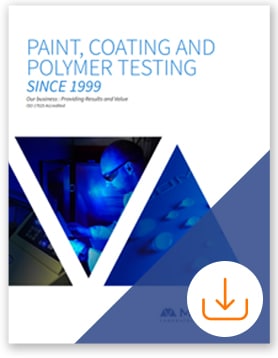ASTM D638
Standard Test Method for Tensile Properties of Plastics
Micom offers testing services according to ASTM D638, which measures the tensile properties of unreinforced and reinforced plastics, including ultimate tensile strength, yield strength, and elongation. Testing the properties of plastics through physical and mechanical testing is an essential aspect of product development and quality control.
ASTM D638 Testing Method
In ASTM D638 Testing, the samples are cut in the form of a standard dumbbell shape. This cut ensures the sample has a reduced section where the break will occur upon testing. A universal tester is used to grip and pull the specimen until failure. The samples are tested in specific conditions such as pre-treatment, sample orientation, temperature, humidity, and testing machine speed.
The ASTM D638 testing standard can be used for testing materials up to 14 mm (0.55 in.) in thickness. However, thin sheeting materials, including film less than 1.0 mm (0.04 in.) in thickness, should be tested using the ASTM D882 test.
Micom Laboratories is A2LA accredited to perform ASTM D638 testing as part of our plastic testing services. Our testing experts ensure the accuracy and reproducibility of the results by carefully modulating the dimensions of the dumbbell, optimizing the cutting process, and controlling the testing conditions.
Contact us to get more information about our plastics and polymer testing services.

Key Mechanical Properties Measured by ASTM D638
The ASTM D638 standard test method for evaluating the tensile properties of plastics involves determining crucial mechanical properties of moulded plastics or specimens obtained from a specific region of a plastic component. The most essential mechanical properties measured are:
- Ultimate tensile strength (UTS): This is the maximum stress that the specimen can withstand before it breaks.
- Yield strength: This is the stress at which the material starts to deform plastically, meaning it does not return to its original shape after the stress is removed.
- Elongation at break: This is the percentage of deformation that occurs in the specimen at the point of failure.
- Modulus of elasticity: This is a measure of the stiffness of the material.
These properties are critical outcomes of physical and mechanical testing of polymers and provide valuable data for material selection and product validation.
ASTM D638 Typical Experimental Parameters
When testing the tensile properties of plastics, the following key parameters must be considered to ensure accurate and reproducible results.
Number of specimens per product: Five specimens are typically tested to ensure accuracy and reproducibility. In some cases, the tensile properties need to be measured both in the machine and perpendicular to the machine’s direction as they can vary substantially from one orientation to the other. This behaviour is called anisotropy.
Crosshead speed: The crosshead speed varies as a function of the material’s rigidity, shape, and thickness. Typically, the softer the material, the faster it will get pulled. The crosshead speed should be between 5 mm per min and 500 mm per min. Please refer to table 1 of the test methods for specific details or contact our experts for assistance.
Dumbbell type: The dumbbell dimensions are modulated as a function of the material’s thickness. Sample cutting is of paramount importance for obtaining accurate and reproducible test results. Dumbbell-shaped specimens have a gauge length of 25 mm or 50 mm; a gauge length of 50 mm is recommended.
Conditioning and testing temperature: Usually, the testing is conducted at 23 ± 2 °C. However, it is not uncommon to test at lower temperatures as plastics get more brittle at colder temperatures. Micom can test at temperatures as low as -78 °C.
Conditioning and testing relative humidity: The testing is conducted at 50 ± 5% relative humidity.
ASTM D638 VS. ISO 527-1
ASTM D638 and ISO 527-1 are two commonly used standards for testing the tensile properties of plastics. Although they share similar objectives, there are several key differences between the two standards. Here are five important differences to keep in mind when comparing ASTM D638 and ISO 527-1:
- The standards were developed by different organizations (ASTM and ISO, respectively).
- They have different specimen dimensions and geometries.
- The testing speeds and strain rates specified in the standards can differ.
- The environmental conditions specified for testing (such as temperature and humidity) may vary.
- The data analysis and reporting requirements can differ between the two standards.
Large multinational manufacturers may test to both ASTM D638 and ISO 527-1, but most customers prefer one standard over the other based on their geographic location. For example, North American manufacturers usually test to ASTM D638 while European and Asian manufacturers primarily test to ISO 527-1.
Other Test Methods Related to ASTM D638 Testing
If you’re looking for complementary tests related to ASTM D638, we invite you to browse our polymer testing services and material testing services. Micom offers a wide range of testing services for various materials, including metals, ceramics, composites, and coatings. Our testing experts are always available to discuss your custom testing requirements and help you choose the appropriate testing method, whether it be ASTM D638, ASTM D882, ASTM D790, ASTM D2126, and more.
We also invite you to download our brochure below to learn more about our paint, coating, and polymer testing services.


